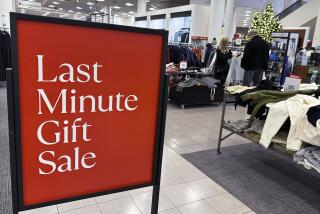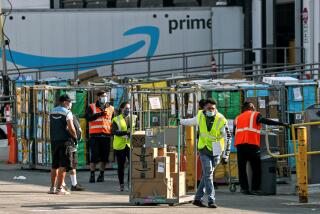Merchants beef up rewards programs to keep consumers coming back
With the holiday shopping season in full swing, several retailers have sweetened the deals on their rewards cards and loyalty programs. The goal: to cater to the deal addiction of cash-strapped customers.
Toys R Us Inc. recently announced it was tripling its Rewards R Us program, offering 10% back on purchases made in stores or online through Christmas Eve. Target Corp.’s RED card program is upping its ante to 5% back on merchandise. GameStop Corp., a leading video game retailer, has unleashed its Power Up Rewards program, a first for the company.
So why are retailers laying on the largess this holiday season? They’re trying to make up for low sales during previous months and keep shoppers coming to them rather than to rivals, experts said.
“Retailers are looking to their loyalty initiatives as a potential way to increase sales and increase foot traffic to their stores leading up to and through the holiday season,” says Dennis Armbruster, vice president of Loyalty One, a company that develops loyalty programs for Fortune 1000 clients including Toys R Us, JCPenney Co. and Best Buy Co.
GameStop rolled out its Power Up Rewards program after positive consumer tests in the summer, said Mike Hogan, senior vice president of marketing for the Grapevine, Texas, company. Aiming for those seeking immediate gratification, GameStop’s program gives customers benefits before they even buy anything.
Members can choose between the free version of the program or paying $14.99 to join Power Up Pro. The paid rewards card offers more year-round deals and discounts than the free version, such as 10% off on used games and a free subscription to Game Informer magazine.
Both versions offer 500 points just for signing up, which can be redeemed for items such as a copy of the “Call of Duty: Black Ops” game signed by the developer, insider visits to game development studios and credits to purchase content on PlayStation Network and X-Box Live.
Some retailers use their rewards programs to bolster relationships with suppliers or brands.
“If a store rewards you for shopping, they may reward you even more for buying a specific brand,” Armbruster said.
Shoppers will find that there’s often a catch. For instance, the 10% Toys R Us rebates are paid in — what else? — “R Us Dollars” that can be spent only at the toy retailer. Still, it triples the program’s usual offering of $5 R Us Dollars for every $150 spent during select earning periods.
Sears Holdings Corp. and its subsidiary Kmart stores are bolstering their Shop Your Way Rewards programs by offering 10 reward points for every dollar spent on certain brands.
To get the most out of rewards programs, experts advise, look for online promotions and programs offered through cards you already have, such as credit cards or frequent flier cards. And shoppers should pay attention to reward expiration dates so they don’t spend in vain.
As savvy as retailers are about getting customers to spend more, consumer expectations are pushing companies to go beyond the typical reward of a 3% to 5% rebate on purchases.
Britt Beemer, marketing strategist and founder of America’s Research Group, said some stores were struggling to keep up with the demand. The research company’s recent Consumer Mind Reader survey found that 74% of shoppers are more “sale driven” then ever before.
“Consumers want such big deals that retailers don’t know what to do,” Beemer said.
There’s a lot at stake for merchants, who have suffered through several disappointing holiday seasons.
“The real challenge is that the size of the market isn’t growing,” Beemer said. “The only way to grow their business is to get customers to spend more money.”






